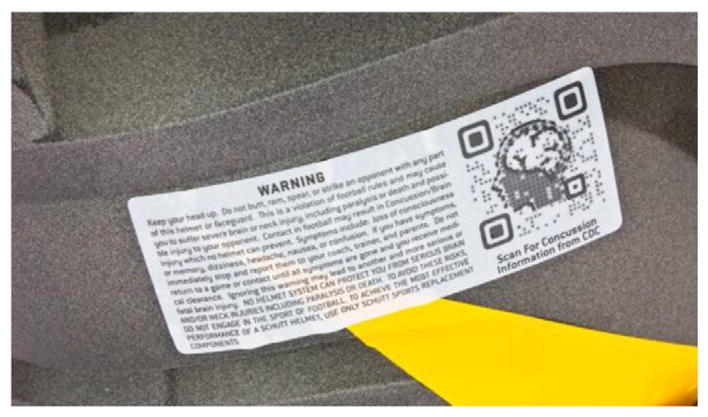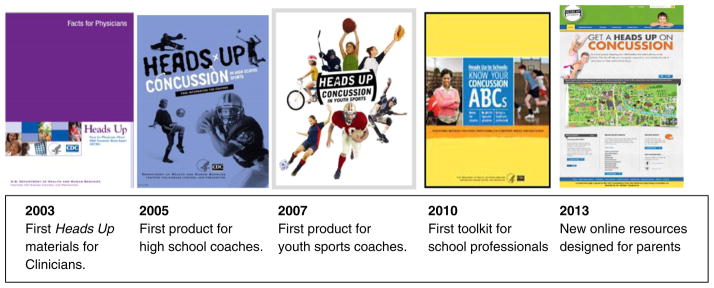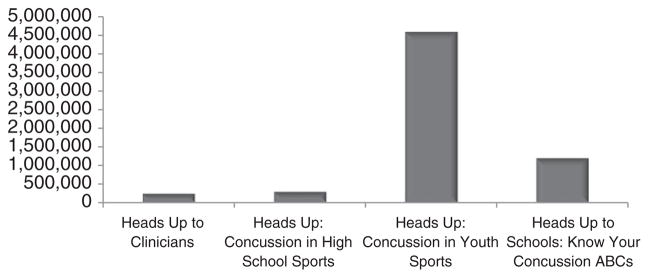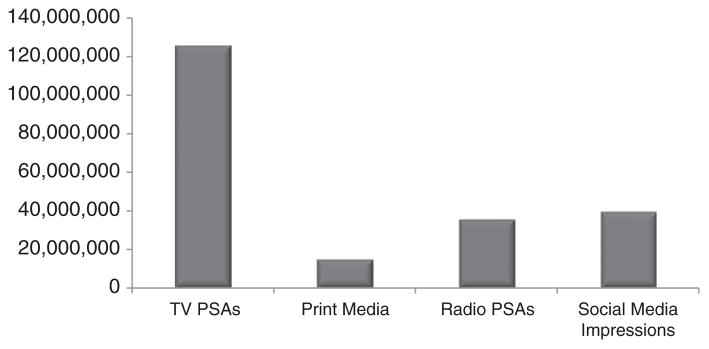1. Introduction
Children and adolescents are at increased risk for concussions, a type of mild traumatic brain injury (TBI) caused by a bump, blow, or jolt to the head or body that can change the way the brain normally works. While most children and adolescents no longer experience symptoms within two weeks of the injury, some—especially those who have a history of concussions—may have symptoms that last for months or even longer (Eisenberg, Andrea, Meehan, & Mannix, 2013). Concussions need to be addressed correctly to help reduce the risk for short- or long-term health problems that can affect a child’s or adolescent’s thinking, learning, behavior, and/or emotions (Brosseau-Lachaine, Gagnon, Forget, & Faubert, 2008; McClincy, Lovell, Pardini, Collins, & Spore, 2006; Moser, Schatz, & Jordan, 2005; Schatz, Moser, Covassin, & Karpf, 2011).
To help address this public health concern, the Children’s Health Act of 2000 (H.R. 4365) (Library of Congress, 1999–2000) charged the Centers for Disease Control and Prevention’s (CDC) National Center for Injury Prevention and Control to implement a public information campaign to broaden public awareness of the health consequences of TBI. In response, CDC developed and launched the Heads Up concussion education campaign. Over the last 10 years, CDC’s Heads Up campaign has grown into a cohesive suite of educational initiatives that share a common goal: to help protect children and adolescents from concussions and other serious brain injuries by raising awareness, enhancing knowledge, and informing action to improve prevention, recognition, and response to concussions. Each CDC Heads Up initiative fulfills these goals by (1) translating the latest concussion science into educational products tailored specifically for the target audiences, and (2) working with partner organizations to disseminate and integrate concussion educational materials and messages into their existing systems and programs. This report describes the process CDC employed to develop and carry out the Heads Up campaign.
2. Methodology
2.1. Defining the audience
In developing the Heads Up initiatives, CDC defined target audiences as those who are in a position to prevent concussions, identify concussion symptoms, and take appropriate action in a variety of environments, at home, school, or play, if a concussion is suspected. CDC used a thorough review of the literature, input from experts, and a national needs assessment to identify the primary target audiences for the concussion education campaign.
2.2. Content development and testing
After identifying target audiences, CDC conducted an environmental scan to assess the current concussion research and the availability of educational materials for each target audience. CDC engaged internal and external content experts to review and provide feedback on the Heads Up materials to ensure accuracy and credibility of the content and design. Expert reviewers brought a deep understanding of the target audiences, as well as practical insights about the contexts in which the materials would be used.
CDC conducted formative testing through focus groups, in-depth interviews, and online surveys to learn about the target audience’s specific information needs and preferences for content, format, design, and distribution channels. All formative testing included geographically and ethnically diverse groups to reflect the diversity of target audiences. Participants in the formative testing were provided with copies of the draft Heads Up materials prior to completing the online survey or to participating in a focus group or interview. All focus groups and in-depth interviews were led by a professional moderator, who used a detailed discussion guide developed by CDC. Discussions were audiotaped and the recordings were transcribed. Results from the formative testing for each audience were used by CDC to revise the design and content of the Heads Up materials prior to release and to inform the distribution of Heads Up materials.
2.3. Product and content dissemination
A number of products (e.g., videos, posters, online trainings, fact sheets) were developed to serve the needs of the various target audiences. To maximize reach and help support a cost-effective approach for broad dissemination of these products, CDC developed partnerships with various organizations from both the public and private sectors. CDC Heads Up partners include health and medical organizations, school organizations, youth-serving organizations, sports organizations, and government agencies. Once a Heads Up product was released, partner organizations disseminate the products through their existing memberships and dissemination mechanisms (such as e-mail lists, newsletters, and social media platforms).
3. Results
3.1. Audience and product development
Over the past 10 years, CDC identified five target audiences: health care professionals, high school coaches, youth sports coaches, school professionals, and parents. The products developed to educate these audiences are encompassed in five Heads Up initiatives (Fig. 1):
Fig. 1.
Timeline of CDC’s Heads Up initiatives.
Heads Up to Clinicians (Centers for Disease Control and Prevention, National Center for Injury Prevention and Control, 2003),
Heads Up: Concussion in High School Sports for high school sports coaches (Centers for Disease Control and Prevention, National Center for Injury Prevention and Control, 2005),
Heads Up: Concussion in Youth Sports for youth sports coaches (Centers for Disease Control and Prevention, National Center for Injury Prevention and Control, 2007),
Heads Up to Schools: Know Your Concussion ABCs for school professionals (Centers for Disease Control Prevention, National Center for Injury Prevention Control, 2010, and
Heads Up to Parents (Centers for Disease Control and Prevention & CDC Foundation, 2013).
Each CDC Heads Up initiative focuses on translating the existing science into educational products tailored specially for the target audience. Using this approach, CDC developed a robust public information campaign designed to meet the needs and interests of the target audiences. In total, the campaign developed more than 50 educational products including:
Checklists and clinical assessment tools,
Clipboard and clipboard stickers,
Fact sheets and booklets,
Magnets and pocket cards,
Mobile application,
Online trainings,
Posters,
Radio and television public service announcements (PSAs), and
Videos.
Each product is designed to provide one or more of the following:
Overview of what a concussion is and the potential effects of this injury;
List of concussion signs and symptoms;
Management or “action” plan that describes what to do if a concussion occurs; and
List of prevention strategies.
Among the most popular products are the three Heads Up online training courses (Fig. 2). The first is the Heads Up to Clinicians (National Football League, CDC Foundation, and Centers for Disease Control and Prevention, 2011). Developed through a grant from the National Football League, this online training for health care professionals focuses on the diagnosis and management of concussion among young athletes. The second is an online training for high school coaches, developed in partnership with the National Federation of State High School Associations (NFHS), entitled Concussion in Sports: What You Need to Know (National Federation of State High School Associations, 2010). Also focused on coaches, the third online course developed by CDC is the Heads Up (Centers for Disease Control and Prevention, National Center for Injury Prevention and Control, 2010) course for youth sports coaches.
Fig. 2.
CDC Heads Up online training courses.
While the formats vary between Heads Up products, each product is designed to be integrated into existing professional health and educational systems and programs. For example, beginning in 2009, states began mandating that coaches complete education on concussion as part of state concussion-in-sports policies (Harvey, 2013). Some of these policies reference or require use of Heads Up online trainings. The integration of Heads Up into state policies on concussion education contributes to the high participation in the Heads Up trainings each year. In fact, more than 1.3 million high school coaches have completed the NFHS/CDC online training since 2010. This is in addition to the 10,000 to 30,000 people per month, on average, who complete CDC’s third course, the Heads Up training for youth sports coaches.
3.2. Evaluation
Chrisman, Schiff, and Rivara (2011) evaluated the Heads Up materials for health care professionals and found positive changes in concussion management. Specifically, health care professionals who were exposed to the Heads Up materials were significantly less likely to recommend returning to play the day after a concussion, which is consistent with current clinical guidance (Chrisman et al., 2011).
In addition, an evaluation of the Heads Up: Concussion in High School Sports initiative was conducted with 330 coaches through surveys and focus group studies. Findings demonstrated that after reviewing the Heads Up materials, 38% of coaches reported making changes in how they dealt with concussions, including placing more emphasis on training techniques and safety equipment that minimize the risk of a concussion (Sarmiento, Mitchko, Klein, & Wong, 2010). Similarly, among youth sports coaches who were exposed to Heads Up educational print materials (including three fact sheets, a clipboard, magnet, poster, and quiz) for approximately 6 months, 77% reported being better at identifying athletes who may have a concussion, 50% reported having learned something new about concussions after reviewing the Heads Up materials, 63% viewed concussions as being more serious, and 72% of coaches reported that they are now educating others about concussions (Covassin, Elbin, & Sarmiento, 2012).
3.3. Dissemination
The Heads Up campaign uses a broad array of dissemination mechanisms including print material, media impressions, and partnerships to distribute its products to the target audiences. Since the launch of the first Heads Up initiative, CDC distributed more than 6 million Heads Up print resources nationwide (Fig. 3). Heads Up resources were distributed and promoted through a range of channels, including the CDC website, partner organizations’ websites, email lists, newsletters, events, conferences, and various social media platforms. The most popular Heads Up print materials include two concussion awareness fact sheets for parents and a fact sheet for young athletes, which are part of the Heads Up: Concussion in Youth Sports initiative. Combined, almost 3 million of these three fact sheets have been distributed (1,077,293 fact sheets for parents; 1,067,105 parent/athlete information sheets; and 873,880 fact sheets for athletes).
Fig. 3.
Number of CDC Heads Up print resources distributed by initiative. *Note: CDC’s Heads Up to Parents initiative is a Web- and mobile-based initiative; thus, no print resources were developed or distributed through CDC for this initiative.
More than 215 million media impressions have been generated through Heads Up television and radio PSAs, as well as through print and social media channels (Fig. 4). The Heads Up television PSAs provided a cost-effective approach for CDC, garnering more than $15 million in free media placement. The Heads Up PSAs have also been distributed and aired by partner organizations. In one example, Major League Baseball (MLB) aired a Heads Up PSA on the MLB network and in baseball stadiums during the MLB playoffs at no cost to CDC.
Fig. 4.
Number of CDC Heads Up media impressions.
An ever-growing and engaged Heads Up Facebook community of over 20,000 fans shares resources and personal stories of concussion. This online conversation helps cultivate connectedness and support among survivors and caregivers (Ahmedi, Sullivan, Schneiders, & McCrory, 2010). During 2013, the Heads Up Facebook page received approximately 200,000 social media impressions weekly.
CDC has partnered with more than 85 organizations including health and medical organizations, school organizations, youth serving organizations, sports organizations, and government agencies. Partnerships facilitated opportunities for CDC Heads Up to reach the target audiences using innovative strategies. For example, CDC partnered with the CDC Foundation to develop and launch the Heads Up app for parents. Created through support from a grant from the National Operating Committee on Standards for Athletic Equipment, the Heads Up app is being promoted in part by a helmet company. This company has imbedded the Heads Up app for parents’ Quick Response (QR) code on each of their helmets (Fig. 5). The QR code directs individuals to the online Heads Up app for parents.
Fig. 5.

Heads Up app for parents’ quick response code.
4. Discussion
Over the last 10 years, CDC’s Heads Up campaign provided educational resources to a wide range of audiences. From the first Heads Up materials for health care professionals launched in 2003, to later efforts focusing on sports programs and schools, Heads Up has helped to raise awareness of the need for improved prevention, recognition, and response to concussion and other serious brain injuries. The success of each Heads Up initiative is in part due to CDC’s use of innovative communication strategies grounded in science and the use of partnerships. Through invaluable partnerships Heads Up materials have landed in the hands of millions of Americans. CDC continues to refine existing products and develop new products to blend with rapid communication channels. For example, Heads Up now employs a greater use of social media and digital materials and has created customizable materials that parents can customize with their child’s team or school logo and colors.
While CDC has seen a growing demand for and use of Heads Up materials, more can be done to improve this public information campaign. In accordance with the recommendation made by the Institute of Medicine’s report on Sports-Related Concussions in Youth: Improving the Science, Changing the Culture (IOM, 2013) and as CDC embarks on the next stage of Heads Up initiatives, greater emphasis will be placed on research and evaluation of the impact Heads Up materials have had on behavior change among health professionals, coaches, parents, and school professionals. CDC will also work with partners to develop and disseminate educational materials to new target audiences, such as children and adolescents. These efforts will be part of an effort to expand Heads Up’s reach and to further document its impact on reducing the incidence and severity of concussions through awareness, education, and training.
Footnotes
Disclaimer: The findings and conclusions in this manuscript are those of the authors and do not necessarily represent the official position of the Centers for Disease Control and Prevention and shall not be used for advertising or product endorsement purposes. Reference herein to any specific commercial products, process, or service by trade name, trademark, manufacturer, or otherwise, does not necessarily constitute or imply its endorsement, recommendation, or favoring by the United States Government or the Centers for Disease Control and Prevention.
References
- Ahmedi OH, Sullivan SJ, Schneiders AG, McCrory P. iSupport: Do social networking sites have a role to play in concussion awareness? Disability and Rehabilitation. 2010;32:1877–1883. doi: 10.3109/09638281003734409. http://dx.doi.org/10.3109/09638281003734409. [DOI] [PubMed] [Google Scholar]
- Brosseau-Lachaine O, Gagnon I, Forget R, Faubert J. Mild traumatic brain injury induces prolonged visual processing deficits in children. Brain Injury. 2008;22:657–668. doi: 10.1080/02699050802203353. http://dx.doi.org/10.1080/02699050802203353. [DOI] [PubMed] [Google Scholar]
- Centers for Disease Control and Prevention & CDC Foundation. Heads up to parents. 2013 Retrieved November 25, 2013, from http://headsupparents.org.
- Centers for Disease Control and Prevention National Center for Injury Prevention and Control. Heads up: Brain injury in your practice. 2003 Retrieved November 25, 2013, from http://www.cdc.gov/concussion/HeadsUp/physicians_tool_kit.html.
- Centers for Disease Control and Prevention National Center for Injury Prevention and Control. Heads up: Concussion in high school sports. 2005 Retrieved November 25, 2013, from http://www.cdc.gov/concussion/HeadsUp/high_school.html.
- Centers for Disease Control and Prevention National Center for Injury Prevention and Control. Heads up: Concussion in youth sports. 2007 Retrieved November 25, 2013, from http://www.cdc.gov/concussion/HeadsUp/youth.html.
- Centers for Disease Control and Prevention, National Center for Injury Prevention and Control. Heads up to schools: Know your concussion ABCs. 2010 Retrieved November 25, 2013, from. http://www.cdc.gov/concussion/HeadsUp/schools.html.
- Centers for Disease Control Prevention, National Center for Injury Prevention Control. Heads up online training course. 2010 Retrieved November 25, 2013, from http://www.cdc.gov/concussion/HeadsUp/online_training.html.
- Chrisman SP, Schiff MA, Rivara FP. Physician concussion knowledge and the effect of mailing the CDC’s “Heads up” toolkit. Clinical Pediatrics (Phila) 2011;50:1031–1039. doi: 10.1177/0009922811410970. http://dx.doi.org/10.1177/0009922811410970. [DOI] [PubMed] [Google Scholar]
- Covassin T, Elbin RJ, Sarmiento K. Educating coaches about concussion in sports: Evaluation of the CDC’s “Heads up: Concussion in youth sports” initiative. The Journal of School Health. 2012;82:233–238. doi: 10.1111/j.1746-1561.2012.00692.x. http://dx.doi.org/10.1111/j.1746-1561.2012.00692.x. [DOI] [PubMed] [Google Scholar]
- Eisenberg MA, Andrea J, Meehan W, Mannix R. Time interval between concussions and symptom duration. Pediatrics. 2013;132:8–17. doi: 10.1542/peds.2013-0432. http://dx.doi.org/10.1542/peds.2013-0432. [DOI] [PubMed] [Google Scholar]
- Harvey HH. Reducing traumatic brain injuries in youth sports: Youth sports traumatic brain injury state laws, January 2009–December 2012. American Journal of Public Health. 2013;103:1249–1254. doi: 10.2105/AJPH.2012.301107. http://dx.doi.org/10.2105/AJPH.2012.301107. [DOI] [PMC free article] [PubMed] [Google Scholar]
- Institute of Medicine (IOM) and National Research Council (NRC) Sports-related concussions in youth: Improving the science, changing the culture. Washington, DC: The National Academies Press; 2013. [PubMed] [Google Scholar]
- Library of Congress. Bill Summary & Status 106th Congress (1999–2000) H.R.436.5. 1999–2000 Retrieved November 21, 2013, from http://thomas.loc.gov/cgi-bin/bdquery/z?d106:H.R.4365.
- McClincy MP, Lovell MR, Pardini J, Collins MW, Spore MK. Recovery from sports concussion in high school and collegiate athletes. Brain Injury. 2006;20:33–39. doi: 10.1080/02699050500309817. [DOI] [PubMed] [Google Scholar]
- Moser RS, Schatz P, Jordan BD. Prolonged effects of concussion in high school athletes. Neurosurgery. 2005;57:300–306. doi: 10.1227/01.neu.0000166663.98616.e4. [DOI] [PubMed] [Google Scholar]
- National Federation of State High School Associations. Concussion in sports: What you need to know. 2010 Retrieved November 25, 2013, from http://nfhslearn.com/electiveDetail.aspx?courseID=38000.
- National Football League CDC Foundation and Centers for Disease Control and Prevention. Heads up to clinicians: Addressing concussion in sports among kids and teens. 2011 Retrieved November 25, 2013, from http://www.cdc.gov/concussion/HeadsUp/clinicians/index.html.
- Sarmiento K, Mitchko J, Klein C, Wong S. Evaluation of the Centers for Disease Control and Prevention’s concussion initiative for high school coaches Heads up: Concussion in high school sports. The Journal of School Health. 2010;80:112–118. doi: 10.1111/j.1746-1561.2010.00491.x. http://dx.doi.org/10.1111/j.1746-1561.2010.00491.x. [DOI] [PubMed] [Google Scholar]
- Schatz P, Moser RS, Covassin T, Karpf R. Early indicators of enduring symptoms in high school athletes with multiple previous concussions. Neurosurgery. 2011;68:1562–1567. doi: 10.1227/NEU.0b013e31820e382e. http://dx.doi.org/10.1227/NEU.0b013e31820e382e. [DOI] [PubMed] [Google Scholar]






